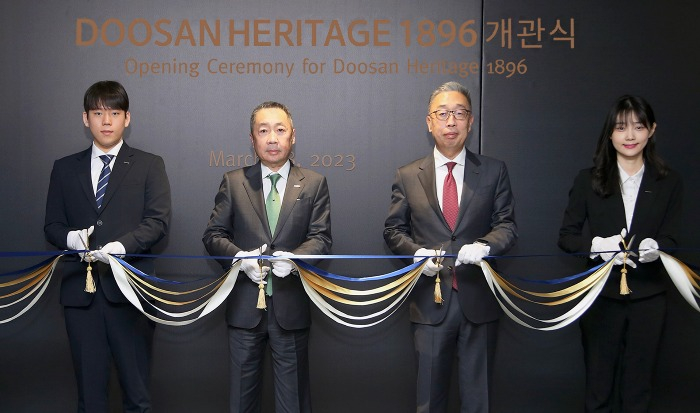Companies
Doosan Group opens museum on its corporate history
Doosan Heritage 1896 displays photos and memorabilia from the conglomerate's 127 years in a southern Seoul suburb
By Mar 29, 2023 (Gmt+09:00)
2
Min read
Most Read
LG Chem to sell water filter business to Glenwood PE for $692 million


Kyobo Life poised to buy Japan’s SBI Group-owned savings bank


KT&G eyes overseas M&A after rejecting activist fund's offer


StockX in merger talks with Naver’s online reseller Kream


Mirae Asset to be named Korea Post’s core real estate fund operator



South Korea's Doosan Group on Tuesday opened Doosan Heritage 1896, a museum displaying 127 years of the conglomerate's history, at Doosan Tower in the southern Seoul suburb of Seongnam, Gyeonggi Province.
The opening ceremony on the morning of the same day was attended by the group's executives and new staff including Chairman Park Jeong-won and Vice Chairman Park Ji-won. "This isn't just a space to mark Doosan's unique history, but also to view Korea's modern and contemporary corporate history and industrial development," the chairman said.
Doosan Heritage 1896 shows the group's origins starting from 1896, when founder Park Seung-jik started a store bearing his name in the Baeogae (now Jongno 4-ga) district of downtown Seoul. Through historical materials from the early 20th century, when Doosan started to take shape as a modern corporation, the exhibits offer a glimpse at the early beginnings of Korea, Inc.
Park Seung-jik Store, which eventually grew into Doosan Group, was an imported cloth store mainly dealing with fabrics such as linen and cotton.
The history hall shows Doosan as an active company dealing in consumer goods. During the nation's rapid economic growth in the mid- and late 1900s, Doosan was the leading domestic company in the field and entered more sectors based on its accumulated know-how in beer production. The group also aggressively collaborated with famous overseas brands such as Coca-Cola, Nestle, 3M, Kodak and Polo.
Entering the 21st century, the group is drastically transforming its business structure from consumer goods to infrastructure. The hall thus also displays components of its gas turbines, wind turbine models and cutting-edge electronics materials.
Other exhibits highlight the history of the conglomerate's branding activities led by the group's pro baseball team Seoul Doosan Bears, as well as changes in corporate identity, corporate social responsibility and advertising. On display are the championship rings, trophies and souvenirs of the Bears, one of the charter members of the domestic league founded in 1982 and six-time champions, and photo materials used to run the team from the time of Park Seung-jik Store in 1941.
The museum's special exhibition room houses records on and the personal effects of the group's first chairman, Park Doo-byung. This executive strived to develop the country's commerce and industry by developing Doosan into a modern enterprise and serving as the longtime president of the Korea Chamber of Commerce and Industry and an association of Asian commerce chambers.
The exhibition hall shows typewriters, notebooks and personal stamps that he used on business trips.
Write to Kyung-Min Kang at kkm1026@hankyung.com
More to Read
-
 Corporate strategyDoosan Group chief checks farm-construction equipment affiliate's strategy in US
Corporate strategyDoosan Group chief checks farm-construction equipment affiliate's strategy in USMar 20, 2023 (Gmt+09:00)
1 Min read -
 ConstructionDoosan wins $640 mn desalination plant deal in Saudi
ConstructionDoosan wins $640 mn desalination plant deal in SaudiAug 03, 2022 (Gmt+09:00)
1 Min read -
 Korean chipmakersDoosan adds chip post-processing to list of growth drivers
Korean chipmakersDoosan adds chip post-processing to list of growth driversJun 15, 2022 (Gmt+09:00)
2 Min read -
 Corporate investmentDoosan to ramp up small nuclear reactor investment
Corporate investmentDoosan to ramp up small nuclear reactor investmentMay 25, 2022 (Gmt+09:00)
2 Min read
Comment 0
LOG IN


